By Debbie Burke
Back in January, I tucked this idea in a folder and promptly forgot about it. Just found it. Unlike my memory, however, this information hasn’t expired.
If you’re not familiar with Public Domain Day, January 1 of each year marks the expiration of 95-year-old copyrights of films, songs, and books. As of January 1, 2020, creative works copyrighted in 1924 became free to use by anyone, hence the term “public domain.”
What does that mean?
We the public can now watch Harold Lloyd’s classic silent films like Girl Shy and Hot Water for free.
https://youtu.be/eFHdRkeEnpM
A composer, musician, dancer, or songwriter can now freely use George Gershwin’s classic “Rhapsody in Blue” and incorporate the tune into a new pop song, rap interpretation, music video, reggae routine, or any other variation they please.
Once the copyright expires on books, plays, or movies, anyone is legally allowed to adapt those stories into prequels, sequels, or offshoots; or take characters derived from the original work and feature them in completely new tales. Authors don’t need to pay a fee or obtain permission from a copyright holder to use them.
The Divine Comedy is an epic poem completed in 1320 by Dante Alighieri. The poem was not protected by copyright. Film maker William Fox adapted a portion of that work into Dante’s Inferno, a silent film that was copyrighted in 1924 and is now in the public domain.The story cards at the beginning explain why Fox made the film:
“In presenting in screen form the more striking scenes of “Dante’s Inferno” we are realizing a cherished ambition. After a long period of careful preparation and thought, we decided to interpret reverently this classic masterpiece in its undisguised truth—weaving into its vivid realism the thread of a simple modern story. Thus the warning of Dante is more definitely emphasized—that by our daily thoughts and acts we may be unconsciously building up for our own future—A VERITABLE HELL ON EARTH.
“In the human brain a thin wall divides a heaven and a hell. Are we hewing down that wall? Are we leaving love and sunshine for the crimson realms of agony and remorse?”
The theme of The Inferno clearly resonated with Fox, inspiring him to update the story to his then-contemporary world. In the same way that Fox took an old poem without a copyright and adapted it to a different era, today’s movie makers might use his 1924 film as the basis and inspiration for new creations.
What can writers do with works in the public domain?
We can re-imagine a timeless theme in a new form.
We can take a classic story and play it out in a different setting. Christopher Robin in space? Peter Pan in a post-apocalyptic world?
We can resurrect a beloved or fascinating character to live again in further adventures.
In the 1924 film, Sherlock Jr., Buster Keaton aspires to be a great detective like Sherlock Holmes and embarks on a series of comic, crime-solving adventures. This silent classic showcases Keaton’s incredible versatility as a director, actor, comedian, and super stunt man. Click on this link for 45 minutes of fun.
Other works that came into the public domain last January include:
Tarzan and the Ant Men by Edgar Rice Burroughs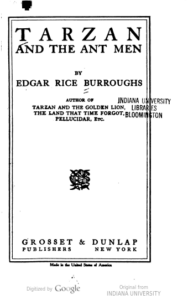
When We Were Very Young by A.A. Milne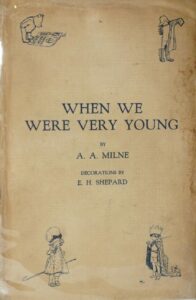
The Magic Mountain by Thomas Mann
The Man in the Brown Suit by Agatha Christie
The first film adaptation of J.M. Barrie’s play, Peter Pan.
Here’s a link to other works that are now in the public domain.
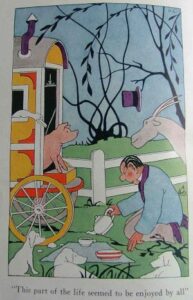 Project Gutenburg makes an extensive collection of public domain works (under Australian copyright laws) available to read for free. As a kid, I was a huge fan of Dr. Doolittle books by Hugh Lofting. After finding the site, I spent an hour happily touring with Dr. Doolittle’s Circus and remembering illustrations I hadn’t seen in 60 years.
Project Gutenburg makes an extensive collection of public domain works (under Australian copyright laws) available to read for free. As a kid, I was a huge fan of Dr. Doolittle books by Hugh Lofting. After finding the site, I spent an hour happily touring with Dr. Doolittle’s Circus and remembering illustrations I hadn’t seen in 60 years.
Today, if I wanted to write a book starring Dr. Doolittle’s sidekick, Matthew Muggs, AKA the Cat’s-Meat-Man, and Mrs. Theodosia Muggs, that is allowable.
It’s not necessary to wait until a work goes into the public domain to use it but you must obtain permission from the copyright holder and/or pay a fee (often hefty). For instance, Desire Under the Elms, the 1924 play by Eugene O’Neill, was adapted into a 1958 movie. At least a portion of the film’s budget went to lawyers negotiating the rights under which O’Neill’s play could become a movie. If producers had waited until 2020, they could have had free, unfettered use of the play. But they’d no longer have the stellar cast from 1958: Sophia Loren, Burl Ives, and Anthony Perkins.
Under earlier copyright law, the term of the copyright for a creative work was 75 years. In 1998, Congress extended the term to 95 years, due in large part to the lobbying of The Walt Disney Company. They wanted longer protection for the ginormous income stream generated by a certain mouse. Under current law, unless another extension is granted, Mickey will enter the public domain in 2024. After that, theoretically, anyone may be able to use Mickey’s image and earn money from it.
Want to bet on that happening?
Nah, me neither.
Works in the public domain can be a source of inspiration for writers to freshen a timeless theme, to create new stories that happen before or after the original work, or to breathe new life into memorable characters.
When Casablanca goes into the public domain in 2037, I’ll write the sequel I’ve had in mind for years…if I’m still around.
Not betting on that either!
~~~
TKZers: Do you ever hanker to write a new episode or sequel to a favorite book or series? Please give examples.
What books or movies do you look forward to being in the public domain?
~~~
Debbie Burke’s latest thriller, Dead Man’s Bluff, will enter the public domain in the year 2115. Or you can buy it now for only $.99.

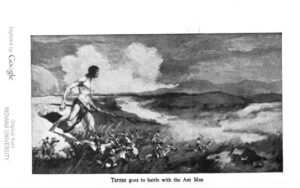
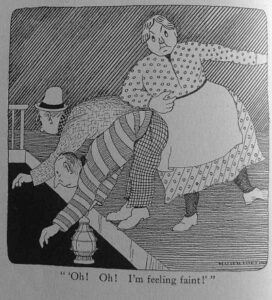
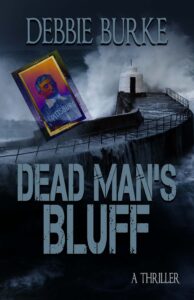
I spent a lot of time learning to write by playing with the Highlander tv series characters.
Terry, that’s a great exercise for new writers. The situation, setting, and characters are already established so the budding author can just concentrate on story.
My first rejection was for a “script” submitted to the TV series, The Man From U*N*C*L*E.
Just to be clear, that 1998 extension of the copyright term to 95 years was only for works of “corporate authorship.” For regular people, the copyright term is still the author’s life plus 70 years.
Thanks for that clarification, Harvey! Copyright law is Byzantine maze. When I read the Duke Law site explanation in the first link, I didn’t pick up that distinction–another reason I’m not an attorney!
I often play a game with myself where I’m with a bunch of friends and we are watching a movie. When the end credits have finished–if there are end credits; sometimes there’s just a THE END and those white spots and vertical lines of light running up the screen–we stand up and yell “SEQUEL!”
Then we each tell what happened to the characters after the movie ended.
[Spoiler]
The SEQUEL! is only played against the movie, not real life. For example–in real life, the Von Trapp family did not sneak out of Austria by taking the Abbey’s automobile, driving to the foothills of the Alps then all seven family members (there were in fact 10 family members) climbing over the famous mountains to Switzerland. They in fact announced the fact they were going to America to sing and left on the train to Italy.
But in The SEQUEL!, the family is secretly chased down by the Gestapo as they are on their way to the train station. Liesl, clearly the most intelligent of all the Von Trapps, breaks away from the family, runs to the local police station and gets three officers to follow her. The officers are taken down by the gunfire. Liesl takes the officers’ guns and returns to the family, passing out the guns to Captain Von Trapp, Maria, and Friedrich who, while she makes runs to the officers to get more ammunition, engage the Gestapo bad guys and wipe them out.
(Note, there is no requirement that reality or credibility governs The SEQUEL! I’m not certain, for example, the policemen in a small Swiss town would even carry guns.)
There are limitations to the game with myself. For example, can you actually play the games using a Star Wars film? Has Stars Wars ever actually ended? Another Harrison Ford series that hasn’t yet ended: a fifth Indiana Jones project has been announced for 2022. Yay!
Some movies make it difficult to think of sequels immediately. How can you possibly think through your tears and throat lumps at the end of Love Story?
There I am. Ready to write the sequel of many movies (yes, I write the sequels down) after the copyrights have expired. Although I’m not certain The Sound of Music shootout would really be a good project. Or, as Dr. Johnson might say, “One of the disadvantages of wine is that it makes a man mistake words for thoughts.” So does popcorn and Pepsi–I don’t drink wine.
And I love the Gutenberg Project.
Sound of Music shootout? That’s hilarious, Jim! Thanks for a wake-up laugh.
Do not write a sequel to Casablanca…ever.
Ditto Gone With the Wind (oops).
I’ve often thought of a sequel to Titanic, in which Jack actually survives. They get married. A year later, Rose looks at him and says, “When are you going to go out and get a job already? And quit sketching me!”
I don’t want to incur your wrath, sir, so I will shelve the Casablanca sequel.
*gasp!* Jack dies in the Titanic? #kidding 😉
Don’t judge me.
I’ve never seen Titanic.
That is all…
SPOILER ALERT: The ship sinks. Snicker. After I saw A NIGHT TO REMEMBER as a kid, I’ve had no desire to see any other Titanic movie. Way too depressing.
Speaking of sequels…I’d like to see a sequel, or an extension, or a what-you-will, to The Godfather. Victor Mancini/Corleone (in The Godfather III, released in 1990) would surely be more complicated and evil than Michael turned out to be. Andy Garcia is one of my favorite actors, and he was excellent in the part.
Don’t know who would write it, though. But if there existed a clone of Puzo to write it, maybe some of Coppola’s prolific actor/director family members could direct…maybe a Nicholas Cage/Talia Shire/Sofia Coppola triad, with Francis Ford consulting.
I’m gonna call someone… 🙂
The Godfather: The Next Generation? Great idea, Deb, lot of threads to follow up in that saga.
Make them an offer they cannot refuse.
Apparently Netflix is currently embroiled in a lawsuit with the Doyle estate over their new mystery series, which features Sherlock Holmes’s niece as a sleuth, with the great detective making an appearance, a kinder version no less. The Doyle estate claims that they hold the copyright on the kinder version of Holmes, which they say is a later invention.
The late, great SF writer and film critic Harlan Ellison observed, about Disney: “Don’t [explective] with the Mouse.” Certainly they have the money and power to extend their copyright if any one can.
“Enola Holmes” is from a book series by Nancy Springer. It’s pretty dang telling that the Doyle Estate has never gone after her or her publisher. Not enough money there to bother them about that book series or any of the other authors using Holmes and/or his crime-solving relatives.
Interesting news about the Doyle estate. This should keep the lawyers busy for a few more decades.
I’ve never considered writing a sequel with another author’s characters. Many did just that in the Kindle Worlds, including me (2 novellas). But I discovered something during that time. Fan fiction isn’t my cup of tea. I’d much rather stay in my own lane. 🙂 Fascinating post, though. Thanks, Debbie!
Sue, I too wondered about Kindle Worlds. Wonder if the copyright issue is the reason KW is no more.
I also prefer my own imaginary playmates!
No, it wasn’t the copyright. The World’s creator needed to approve each author who wrote in their world. That was true of the Worlds I wrote in anyway. One day Amazon just canceled the program. Probably wasn’t profitable enough.
Thanks for that clarification, Sue.
Same thing happened with Amazon’s Kindle Scout program. Usually boils down to money.
I think it would be fun to write an episode for one of the mystery series I like: Foyle’s War, Midsomer Murders, or Endeavour. The British have a way with mysteries.
Btw, speaking of copyright, I wanted to use the first two lines of the famous tune “Heigh-ho, heigh-ho, it’s off to work we go” in my first book. I was so determined, I got the name of the company that owns the copyright (I don’t think it was Disney) and requested permission to use just those two lines in a little ditty I wanted a software developer to sing while he was looking for a bug. I was willing to pay. They refused permission! So I made up my own little song instead. I think it’s better.
Under no circumstances, should an author toss in music lyrics into their works. Music has copyright protectors who are beyond zealots. Copyright fair use and proper attribution which are both perfectly legal don’t matter to them, and they, usually ASCAP, will go after a writer for even the slightest mention. They have the lawyers and the money so they win almost every time. If you go the legal route and try to pay for the use of a few lines through ASCAP, the amount will be larger than the profit from that book.
Kay, good for you for making up your own lyrics.
I recently read about an author who wanted to use lines from different songs for his each of his chapter titles. Sounds good until you start receiving legal notices.
Titles aren’t covered by copyright, but they can be trademarked. With the costs involved, that only happens when the title becomes part of a media franchise.
I had intended to use pop standard titles for my romances, but I only had TIME AFTER TIME published.
Wicked: The Life and Times of the Wicked Witch of the West, was published in 1995, written by Gregory Maguire. He followed with three more in the “Wicked” series based on Frank Baum’s memorable Wizard of Oz books originally published in the early 1900s. I loved Maguire’s idea for a look at the dark side of the characters, of magic, of the world left behind by Dorothy. I read two of the books 25 years ago, so I’ve forgotten most details. Merits a new look perhaps.
Wicked is a great example, Dan. It also became a hugely successful stage musical.
I’ve delved into copyright law for years because of my work against copyright pirates, then one of my publishers decided to sell text-to-speech versions of our books without having audio book rights, and that led me on another journey into secondary book rights. Anyway, I have a number of articles on my blog on this subject that anyone here is more than welcome to use on their own blog. Of special interest are my articles “A Reader’s Guide to Copyright” and “First Sale Doctrine and Ebooks.” All I ask for the use is a note to me because I’m nosy. The usual disclaimer: I’m not a lawyer, just an interested copyright nerd.
http://mbyerly.blogspot.com/search/label/copyright
NOTE: My writing blog is not monetized in any way, and I don’t even shill my books or teaching courses there. I offer info because I’m a teacher, and I love to teach. No other ulterior motives.
As everyone here knows, we writers have far more book ideas than time to write them so the primary use of in-public-domain books is marketing, not creativity. Write a mystery about a Victorian detective, and we sell some books. Write a mystery about Sherlock Holmes, and we sell a lot of books because of the name recognition. So, I’ve never bought into the idea that out-of-copyright franchises are about creativity, and I’ve never used public domain works except for Shakespeare.
One of my OOP published novels is “Romeo and Juliet” in spaaaaace with genders instead of rich families at war. Surprisingly, no reviewer or reader has ever said anything about the use of “Romeo and Juliet” in STAR-CROSSED. An unpublished work was structured on “The Tempest.”
Thanks, Marilynn, for the link. I also read the post right below about musical lyrics. The way you handled references to songs to evoke the desired emotion was masterful!
Anyone who’s interested in using songs in their own work should read Marilynn’s post: http://mbyerly.blogspot.com/2019/07/using-music-in-your-fiction.html
“Peter Pan in a post-apocalyptic world?” Peter Pan? Don’t even think about it, and don’t go there — unless you want to get burned big style. Despite Disney’s buccaneering, Peter Pan is protected by a special law, which supersedes all other copyright and intellectual property laws, introduced by the UK parliament in 1988. The law effectively extended copyrights pertaining to the Peter Pan character into perpetuity. The reason being is that J.M. Barrie, the author of the Peter Pan stories, gifted all rights to the character, Peter Pan, to Great Ormond Street Hospital — London’s principal childrens’ hospital. (Where, incidentally, my son-in-law works as a paediatric surgeon). To this day, following the release of the Peter Pan animation in 1954, Disney has made undisclosed annual amounts to the Trust which owns and administers the Peter Pan copyright.
How interesting, Bill. Thanks for shedding light on that unusual situation. What an amazing legacy J.M Barrie left to help generations of children.
Thanks for the reminder, Debbie. I loved the Dr. Doolittle books as a child as well. Family members call me by that name because for whatever reason I seem to have a special connection with animals (it’s not a connection; animals can spot a softie from a mile away).
Thanks for a great post!
Thanks, Joe.
Rex Harrison was a wonderful actor but badly miscast in the movie version. Hugh Lofting’s roly-poly little Dr. Doolittle with the half-moon nose was too imprinted in my mind.
Soft touch? Gotta go, there’s a squirrel tapping on the patio door for a peanut.
Great heads up, as I have toyed with the idea of writing the rumored/mythical final Travis Magee novel, allegedly titled _A Black Border for Magee_ – might still be worth the exercise (like your _Cassablanca_ idea – as an exercise – otherwise the esteemed Mr.Bell may resurrect his law license on behalf of both copyright holders and prosecute pro-bono ? ).
George, check out this post on the JDM website by his son Maynard. It recounts various authors who’ve submitted sequels to the estate…including McDonald’s good friend, Stephen King! Now THAT would be a sequel!
http://jdmhomepage.org/the-legacy-and-the-question.html